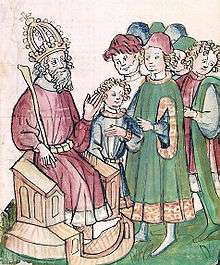Seven Wise Masters
The Seven Wise Masters (also called The Seven Sages or The Seven Sages of Rome) is a cycle of stories of Sanskrit, Persian or Hebrew origins.

Story and plot
The Sultan sends his son the young Prince to be educated away from the court in the seven liberal arts by Seven Wise Masters. On his return to court his stepmother the empress seeks to seduce him. To avert danger he is bound over to a week's silence by Sindibad, leader of the Seven Wise Masters. During this time the empress accuses him to her husband, and seeks to bring about his death by seven stories which she relates to the emperor; but her narrative is each time confuted by the Seven Wise Masters led by Sindibad. Finally the prince's lips are unsealed, the truth exposed, and the wicked empress is executed.
The frame narrative served as the flexible way to transmit tales to other listeners.
Hundreds of surviving European texts are known.[1] These normally contain fifteen tales, one for each sage, seven from the stepmother, and one from the prince; though the framework is preserved, only four of the commonest European tales are also found in the Eastern version.[2]
Origins
The cycle of stories, which appears in many European languages, is of Eastern origin. An analogous collection occurs in Sanskrit, attributed to the Indian philosopher Sindibad/Syntipas in the first century BC, though the Indian original is unknown. Other suggested origins are Persian (since the earliest surviving texts are in Persian) and Hebrew (a culture with similar tales, such as that of the biblical Joseph) .
Bibliography
Runte, Hans R., J. Keith Wikeley and Anthony J. Farrell, The Seven Sages of Rome and the Book of Sindbad: An Analytical Bibliography, New York: Garland Publishing, Inc., 1984 (Garland Reference Library of the Humanities).
The Seven Sages Society, founded in 1975, maintains a perpetual scholarly bibliography, with annual updates in its on-line and printed (free of charge) Newsletter, at <http://sevensagessociety.org>.
Travelling from the east by way of Arabic, Persian, Syriac and Greek, it was known as the book of Sindibd, and was translated from Greek into Latin in the 12th century by Jean de Hauteseille (Joannes de Alta Silva), a monk of the abbey of Haute-Seille near Toul, with the title of Dolopathos (ed. Hermann Österley, Strassburg, 1873). This was translated into French about 1210 by a trouvère named Herbers as Li romans de Dolopathos; another French version, Li Romans des sept sages, was based on a different Latin original. The German, English, French and Spanish chapbooks of the cycle are generally based on a Latin original differing from these. Three metrical romances probably based on the French, and dating from the 14th century, exist in English. The most important of these is The Sevyn Sages by John Rolland of Dalkeith edited for the Bannatyne Club (Edinburgh, 1837).
History later: The collection later supplied tales that circulated in both oral and written traditions. Giovanni Boccaccio used many of them for his famous work, the Decameron.
The Latin romance was frequently printed in the 15th century, and Wynkyn de Worde printed an English version about 1515. See:
- Gaston Paris, Deux rédactions du "Roman des sept sages de Rome" (Paris, Société des anciens textes français, 1876)
- Georg Büchner, Historia septem sapientium (Erlangen, 1889)
- Killis Campbell, A Study of the Romance of the Seven Sages with special reference to the middle English versions (Baltimore, 1898)
- Domenico Comparetti, Researches respecting the Book of Sindibdd (Folk-Lore Soc., 1882).
References
Sources
- Irwin, Bonnie D. "The Seven Sages," in Madieval Folklore: A Guide to Myths, Legends, Beliefs, and Customs, Carl Lindahl, John McNamara and John Lindow, eds. Oxford University Press, 2002.
 This article incorporates text from a publication now in the public domain: Chisholm, Hugh, ed. (1911). "article name needed". Encyclopædia Britannica (11th ed.). Cambridge University Press.
This article incorporates text from a publication now in the public domain: Chisholm, Hugh, ed. (1911). "article name needed". Encyclopædia Britannica (11th ed.). Cambridge University Press.